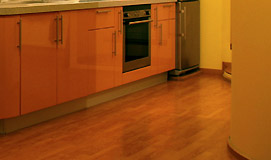Feature
Colour is a very important design element for kitchens as it plays such an important role in affecting moods. A good combination of colours can make your kitchen look livelier and more appealing. However, mismatched colour schemes can ruin your décor.
Colour can influence the mood of a room. Studies have shown that red can quicken the pulse and breathing rate, as well as increase appetite. Yellow, especially soft yellow, can make people feel happier. When used as an accent colour, bright yellow can attract attention and brighten up a kitchen. You can also use colour to influence how large or intimate a kitchen feels.
With colour taking on more importance, many manufacturers of cabinets, appliances, flooring and countertops are offering the consumer more choices. The most popular kitchen colours include shades of brown, yellow, red, green and blue, although pastel colours have made a reappearance in vintage-style and shabby chic kitchens. Along with colour, surface texture has become of utmost importance from stainless steel to natural woods, glass to polished surfaces.
White remains a popular choice because of it has a clean look. One disadvantage of an all-white kitchen is that it can have a sterile and cold look and feel, which is why white is usually accented with another colour. Also, design elements such as a light coloured oak floor or soft accents provided by fabric blinds can make a kitchen seem warmer.
You can feel safe selecting just about any colour for your kitchen by following some important guidelines:
Neutral colours, including taupe, tan, black, white, cream and shades of grey, can be paired with almost any colour as an accent. Because cabinets make up most of the expense of kitchen decorating, it is better to choose a style in a more neutral finish. This also applies for countertops and flooring.
A good decorating scheme is to emulate the colour schemes found in nature, such as sky blue or the various shades of green or earth brown or light or pale yellow. Light can also play an important part in emphasising colours and can bring about different shades in varying intensity.
Whatever colour you choose, interior design encourages homeowners to select one base colour and one or two accent colours.
It is considered a good idea to use three colours in a room with a 60-30-10 split between them. Sixty per cent should make up the base colour, probably on the walls or cabinets; 30 per cent should make up the secondary colour, used in the flooring, rugs and window treatments; and accents such as kitchen ware, artwork, pillows and other soft items should make up the last 10 per cent.
Monochromatic colour schemes can benefit from the use of various tints, tones and shades. A splash of strong colour, such as red, can liven up a monochrome look.
Complementary colours use two colours placed opposite to each other on the colour wheel, such as purple and yellow, red and green, or turquoise and orange. This scheme is quite intense and brings a more dramatic touch and energy to home décor.
Picture caption: Yellow is one of the most popular colours when decorating a kitchen, as it brightens the room up and attracts attention.

Colours Colour for effect Colour therapy for kitchens How light affects interior colour schemes
Tips and Tricks Interior styling for outdoor rooms See double when decorating Quick interior design tricks
House and Home Bring home the finishing touches Gadget-loving generation Renovating Britain
2 X BUILDING SERVICES INTERMEDIATE...
Area Sales Manager / Business...
Electrician (Maintenance)...
Kitchen Porter - Hilton London Hyde...
Medical Service Engineer /...
more jobs...
Engineering...: 1,967 Jobs
2 X BUILDING SERVICES INTERMEDIATE...
Area Sales Manager / Business...
Electrician (Maintenance)...
Medical Service Engineer /...
PPA Teacher for P.E. or ICT...
more jobs...
Chief Financial Officer - Property...
Electrical Testers...
Operations Manager...
Real Estate Fund Associate -...
Senior Property Manager...
more jobs...
Sales...: 606 Jobs
Associate Director...
Digital Agency Sales Executive -...
Graduate Sales Opportunity...
PR & Marketing Executive / PR...
Sales Manager / Business...
more jobs...


David said on 29th September...
"Colour Therapy is a complementary therapy that all of us can use and benefit from. www.colourtherapyhealing.com is an information resource about the subject and provides professional information for anyone interested in the subject. "
Dan said on 23rd July ...
"just writing to let you know about a new colour therapy website: www.coloursofthesoul.com Enjoy! "